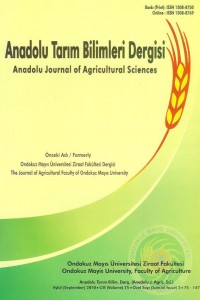LAND USE CAPABILITY CLASS DATA WITH LAND FORMS USING GIS CASE STUDY, SAMSUN-BAFRA DISTRICT
Öz
Land use capability class (LUCC) is of great importance in guiding on land uses in terms of their potential and conserving natural resources for next generations. The concept of land capability is useful in this respect because it is a composite assessment of land and soil, which incorporates the key physical characteristics that limit sustainable land management. Such an approach is simple and logical in approach, is widely known and accepted in the rural community and has been applied widely. LUCC system the range of suited crops decreased from class 1 to 8 and the management inputs required to produce suited crops increases from class 1 to class 8. However, the combination of soils, climate and types of agriculture in a particular area or region may make certain lower capability lands valuable for agriculture. Join analysis of LUCC with topography offers a precious tool to agricultural practices and land use planners revealing the most suitable land for agricultural aims both from LUCC and physiographic point of view. The main objective of this study was to determine relationship LUCC and land forms using GIS in Bafra Plain and near district found in the Kızılırmak Delta and located in the central Black Sea region of Turkey. The study area covers about 77796.1 ha. In this study, LUCC information derived from soil database prepared by the Rural Affairs General Directory and topographic maps scaled 1:25.000 to generate digital elevation model (DEM) were used. According to LUCC distribution of the study area, suitable land for agricultural application ranged from class 1 to class 4 is 53244.4 ha whereas, 24551.7 ha of the total area is non suitable (from class 5 to 8) for tillage. Land slope, aspect, hill shade, drainage network, creation of a three dimensional network structure of earth surface are among application of DEM. In finally, LUCC map painted in various colors was combined by the hill-shade image to generate three dimensional view images.
Anahtar Kelimeler
Kaynakça
- Amundson, R. 1994. Factors of Soil Formation. A System of Quantitative Pedology. Foreword by R. Amundson. Dover Publ.Inc. NY.USA., pp. 281.
- Bibby, J.S., Douglas, H.A., Thomasson, A.J., Roberston, J.S., 1991. Land Capability Classification for Agriculture, MLURI, Aberdeen, UK.
- Brady, N.C., Weil, R.R., 2001, The Nature and Properties of Soils (13th ed.): Prentice Hall, Upper Saddle River, NJ, 960 p.
- CLI. 1972. Soil Capability Classification for Agriculture. The Canada Land Inventory Report No. 2. Lands Directorate. Department of the Environment. Ottawa, Ontario.
- Daniels, R.B., Hammer, R.D., 1992. Soil Geomorphology. John Wiley and Sons. New York, pp: 236.Durak, A. and Surucu, A. 2005. Soil Formation on Different Landscape in a Semi-humid Region of Turkey. Journal of Agronomy, 4(3): 191-195.
- Klingebiel, A.A., Montgomery, P.H., 1961. Land Capability Classification. US Department of Agriculture Handbook 210, GovernmentPrinter, Washington DC, US.
- USDA, 2000. Summary Report: 1997 National Resources Inventory (revised December 2000), U.S. Department of Agriculture, Natural Resources Conservation Service, Washington, DC, and Statistical Laboratory, Iowa State University, Ames, Iowa, US.
- McRae, S.G., Burnham, C.P., 1981. Land evaluation. Monogr. soil survey. Clarendon Press.
- Soil Survey Staff, 1958. Land Capability Classification. Soils Memorandum SCS-22. Soil Conservation Service, Washington, DC.
- U.S. Department of Agriculture. Soil Conservation Service. Soil Survey Staff, 1951. Soil Survey Manual. U.S. Department of Agriculture Handbook. 18, U.S. Government Printing Office. Washington, D.C. 503 pp., illustrated.
- U.S. Department of Agriculture. Soil Conservation Service. Soil Survey Division Staff. 1993. Soil Survey Manual. U.S. Department of Agriculture Handbook. 18, U.S. Government Printing Office. Washington, D.C. 437 pp., illustrated.
- Young, F.J., Hammer, R.D., 2000. Soil-landform Relationships on a Loess-Mamtled Upland Landscape in Missouri. Soil Sci. Soc. Am. J., 64: 1443-1454.
A. ERKOÇAK1 O. DE GİZ1,* Ş. KILIÇ2
Öz
Kaynakça
- Amundson, R. 1994. Factors of Soil Formation. A System of Quantitative Pedology. Foreword by R. Amundson. Dover Publ.Inc. NY.USA., pp. 281.
- Bibby, J.S., Douglas, H.A., Thomasson, A.J., Roberston, J.S., 1991. Land Capability Classification for Agriculture, MLURI, Aberdeen, UK.
- Brady, N.C., Weil, R.R., 2001, The Nature and Properties of Soils (13th ed.): Prentice Hall, Upper Saddle River, NJ, 960 p.
- CLI. 1972. Soil Capability Classification for Agriculture. The Canada Land Inventory Report No. 2. Lands Directorate. Department of the Environment. Ottawa, Ontario.
- Daniels, R.B., Hammer, R.D., 1992. Soil Geomorphology. John Wiley and Sons. New York, pp: 236.Durak, A. and Surucu, A. 2005. Soil Formation on Different Landscape in a Semi-humid Region of Turkey. Journal of Agronomy, 4(3): 191-195.
- Klingebiel, A.A., Montgomery, P.H., 1961. Land Capability Classification. US Department of Agriculture Handbook 210, GovernmentPrinter, Washington DC, US.
- USDA, 2000. Summary Report: 1997 National Resources Inventory (revised December 2000), U.S. Department of Agriculture, Natural Resources Conservation Service, Washington, DC, and Statistical Laboratory, Iowa State University, Ames, Iowa, US.
- McRae, S.G., Burnham, C.P., 1981. Land evaluation. Monogr. soil survey. Clarendon Press.
- Soil Survey Staff, 1958. Land Capability Classification. Soils Memorandum SCS-22. Soil Conservation Service, Washington, DC.
- U.S. Department of Agriculture. Soil Conservation Service. Soil Survey Staff, 1951. Soil Survey Manual. U.S. Department of Agriculture Handbook. 18, U.S. Government Printing Office. Washington, D.C. 503 pp., illustrated.
- U.S. Department of Agriculture. Soil Conservation Service. Soil Survey Division Staff. 1993. Soil Survey Manual. U.S. Department of Agriculture Handbook. 18, U.S. Government Printing Office. Washington, D.C. 437 pp., illustrated.
- Young, F.J., Hammer, R.D., 2000. Soil-landform Relationships on a Loess-Mamtled Upland Landscape in Missouri. Soil Sci. Soc. Am. J., 64: 1443-1454.
Ayrıntılar
| Birincil Dil | İngilizce |
|---|---|
| Bölüm | Toprak Bilimi ve Bitki Besleme |
| Yazarlar | |
| Yayımlanma Tarihi | 20 Ağustos 2010 |
| Yayımlandığı Sayı | Yıl 2010 Cilt: 25 Sayı: 2 |

